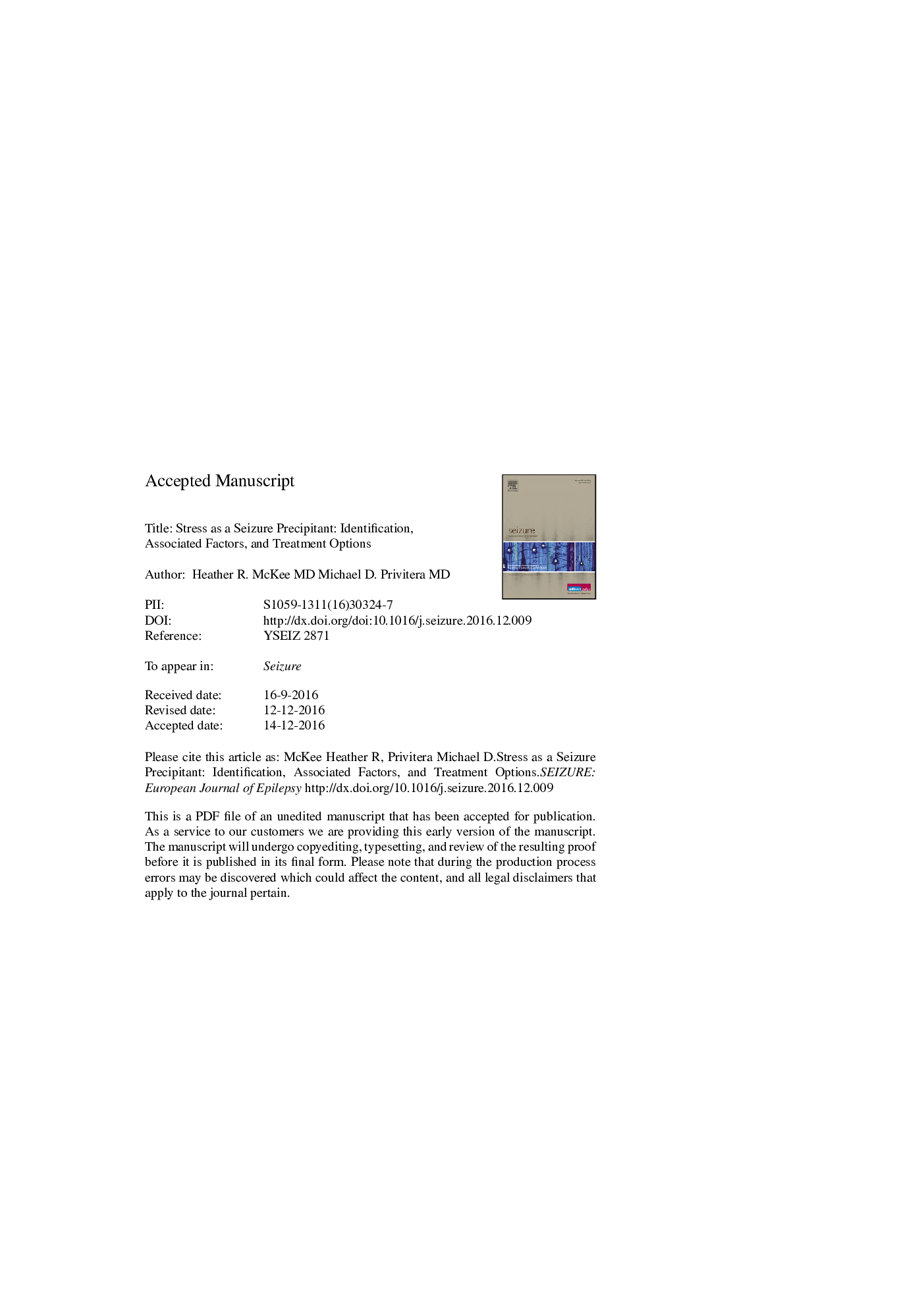| کد مقاله | کد نشریه | سال انتشار | مقاله انگلیسی | نسخه تمام متن |
|---|---|---|---|---|
| 4935511 | 1434222 | 2017 | 18 صفحه PDF | دانلود رایگان |
عنوان انگلیسی مقاله ISI
Stress as a seizure precipitant: Identification, associated factors, and treatment options
ترجمه فارسی عنوان
استرس به عنوان یک پیشگیر تشنج: شناسایی، عوامل مرتبط و گزینه های درمان
دانلود مقاله + سفارش ترجمه
دانلود مقاله ISI انگلیسی
رایگان برای ایرانیان
کلمات کلیدی
فشار، صرع، تصرف، روان درمانی، اضطراب، افسردگی،
ترجمه چکیده
استرس شایعترین تشنجی است که توسط بیماران صرعی گزارش شده است. مطالعات تا به امروز از روش های مختلفی برای شناسایی روابط بین صرع و استرس استفاده کرده اند. مطالعات متعدد نشان داده است که اضطراب، افسردگی و آسیب های دوران کودکی در بیماران مبتلا به صرع شایع تر است و استرس را به عنوان یک تشخیص تشنج در مقایسه با بیماران مبتلا به صرع که استرس را به عنوان یک تشنج تشخیص داده اند، گزارش نمی کنند. در یکی از مطالعات بررسی شده مشخص شد که اکثر بیماران مبتلا به تشنج ناشی از استرس نوعی از روش کاهش استرس را به تنهایی مورد استفاده قرار داده اند و از کسانی که سعی در این امر داشتند، اکثریت حاکی از آن بودند که این روش تشنج خود را بهبود بخشید. علاوه بر این، آزمایشهای آتی آتی، از جمله کارآزمایی های بالینی تصادفی، با استفاده از روشهای کاهش استرس عمومی، وعده بهبود نتایج در بیماران مبتلا به صرع را نشان داده اند، اما نتایج بروز تشنج نا متناقض است. بر اساس این مطالعات، توصیه می شود هنگامی که پزشکان با بیمارانی که استرس را به عنوان یک تشنج تشخیص داده اند، روبرو می شوند، این بیماران باید برای یک اختلال روان شناختی درمان شوند. علاوه بر این، اگر چه کاهش روش تشنج با روش های کاهش استرس در یک کارآزمایی کنترل شده تصادفی ثابت نشده است، اما دیگر اهداف مهم مانند کیفیت زندگی بهبود یافته اند. بنابراین توصیه کردن روش های کاهش استرس به بیماران مبتلا به صرع به عنوان معیار خطر پایین همراه با درمان استاندارد است. بررسی حاضر، نیاز به تحقیقات آینده را برای کمک بیشتر به تشخیص مکانیزم های بیولوژیک روابط استرسزا و تأکید بر نیاز به آزمایشات تصادفی کنترل شده بزرگ برای کمک به ایجاد توصیه های درمان مبتنی بر شواهد برای بیماران مبتلا به صرع نشان می دهد.
موضوعات مرتبط
علوم زیستی و بیوفناوری
علم عصب شناسی
علوم اعصاب رفتاری
چکیده انگلیسی
Stress is a common and important seizure precipitant reported by epilepsy patients. Studies to date have used different methodologies to identify relationships between epilepsy and stress. Several studies have identified anxiety, depression, and childhood trauma as being more common in patients with epilepsy who report stress as a seizure precipitant compared to patients with epilepsy who did not identify stress as a seizure precipitant. In one survey study it was found that a majority of patients with stress-triggered seizures had used some type of stress reduction method on their own and, of those who tried this, an even larger majority felt that these methods improved their seizures. Additionally, small to moderate sized prospective trials, including randomized clinical trials, using general stress reduction methods have shown promise in improving outcomes in patients with epilepsy, but results on seizure frequency have been inconsistent. Based on these studies, we recommend that when clinicians encounter patients who report stress as a seizure precipitant, these patients should be screened for a treatable mood disorder. Furthermore, although seizure reduction with stress reduction methods has not been proven in a randomized controlled trial, other important endpoints like quality of life were improved. Therefore, recommending stress reduction methods to patients with epilepsy appears to be a reasonable low risk adjunctive to standard treatments. The current review highlights the need for future research to help further clarify biological mechanisms of the stress-seizure relationship and emphasizes the need for larger randomized controlled trials to help develop evidence based treatment recommendations for our epilepsy patients.
ناشر
Database: Elsevier - ScienceDirect (ساینس دایرکت)
Journal: Seizure - Volume 44, January 2017, Pages 21-26
Journal: Seizure - Volume 44, January 2017, Pages 21-26
نویسندگان
Heather R. McKee, Michael D. Privitera,
